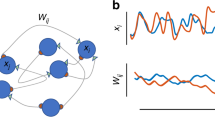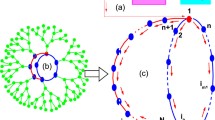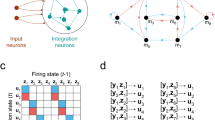Abstract
Networks of neurons in some brain areas are flexible enough to encode new memories quickly. Using a standard firing rate model of recurrent networks, we develop a theory of flexible memory networks. Our main results characterize networks having the maximal number of flexible memory patterns, given a constraint graph on the network’s connectivity matrix. Modulo a mild topological condition, we find a close connection between maximally flexible networks and rank 1 matrices. The topological condition is H 1(X;ℤ)=0, where X is the clique complex associated to the network’s constraint graph; this condition is generically satisfied for large random networks that are not overly sparse. In order to prove our main results, we develop some matrix-theoretic tools and present them in a self-contained section independent of the neuroscience context.
Similar content being viewed by others
References
Abbott, L. F., & Regehr, W. G. (2004). Synaptic computation. Nature, 431(7010), 796–803.
Dayan, P., & Abbott, L. F. (2001). Theoretical neuroscience. Cambridge: MIT Press.
Ermentrout, G. B., & Terman, D. H. (2010). Mathematical foundations of neuroscience. Berlin: Springer.
Geffen, M. N., Broome, B. M., Laurent, G., & Meister, M. (2009). Neural encoding of rapidly fluctuating odors. Neuron, 61(4), 570–586.
Hahnloser, R. H., Seung, H. S., & Slotine, J. J. (2003). Permitted and forbidden sets in symmetric threshold-linear networks. Neural Comput., 15(3), 621–638.
Hatcher, A. (2002). Algebraic topology. Cambridge: Cambridge University Press.
Hopfield, J. J. (1982). Neural networks and physical systems with emergent collective computational abilities. Proc. Natl. Acad. Sci., 79(8), 2554–2558.
Itskov, V., Curto, C., Pastalkova, E., & Buzsáki, G. (2011). Cell assembly sequences arising from spike threshold adaptation keep track of time in the hippocampus. J. Neurosci., 31(8), 2828–2834.
Kahle, M. (2009). Topology of random clique complexes. Discrete Math., 309(6), 1658–1671.
Kerchner, G. A., & Nicoll, R. A. (2008). Silent synapses and the emergence of a postsynaptic mechanism for LTP. Nat. Rev., Neurosci., 9(11), 813–825.
McNaughton, B. L., Battaglia, F. P., Jensen, O., Moser, E. I., & Moser, M. B. (2006). Path integration and the neural basis of the ‘cognitive map’. Nat. Rev., Neurosci., 7(8), 663–678.
Romani, S., & Tsodyks, M. (2010). Continuous attractors with morphed/correlated maps. PLoS Comput Biol 6(8).
Rutishauser, U., Mamelak, A. N., & Schuman, E. M. (2006). Single-trial learning of novel stimuli by individual neurons of the human hippocampus-amygdala complex. Neuron, 49(6), 805–813.
Samsonovich, A., & McNaughton, B. L. (1997). Path integration and cognitive mapping in a continuous attractor neural network model. J. Neurosci., 17(15), 5900–5920.
Author information
Authors and Affiliations
Corresponding author
Rights and permissions
About this article
Cite this article
Curto, C., Degeratu, A. & Itskov, V. Flexible Memory Networks. Bull Math Biol 74, 590–614 (2012). https://doi.org/10.1007/s11538-011-9678-9
Received:
Accepted:
Published:
Issue Date:
DOI: https://doi.org/10.1007/s11538-011-9678-9




